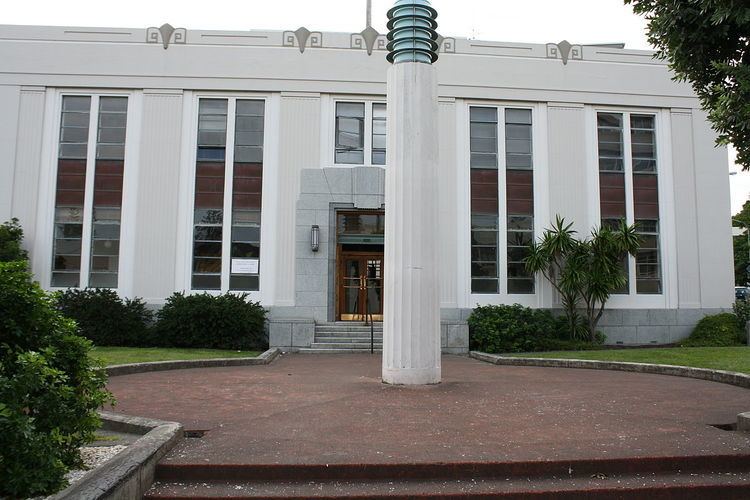 | ||
The New Zealand Ministry of Works and Development, formerly the Department of Public Works and often referred to as the Public Works Department or PWD, was founded in 1876 and disestablished and privatised in 1988. The Ministry had its own Cabinet-level responsible minister, the Minister of Works or Minister of Public Works.
Contents
Structure and operations
The Head Office of the Ministry was in the Vogel Building in Wellington, named after former Premier Sir Julius Vogel, who helped create the Public Works Department during his term in office, through the Immigration and Public Works Act 1870. This building held the Vogel Computer, one of the largest in New Zealand and used by several government departments for engineering work. The Ministry moved to the Vogel Building in about 1965 from the Old Government Building on Lambton Quay.
The ministry was renamed the Ministry of Works on 16 March 1943 under the Ministry of Works Act. This was to reflect the extended wartime functions, when the Minister explained it was, "to ensure that, whilst the building and constructional potential of the country is limited by war and immediate post-war conditions, it is assembled and utilized in the most efficient manner from the point of view of the national interest".
During the latter years of the Ministry there were seven District Offices (Auckland, Hamilton, Wanganui, Napier, Wellington, Christchurch and Dunedin) each headed by a District Commissioner of Works. In each District there were a number of Residency Offices (headed by a Resident Engineer) and each had a number of Depots. In addition there were Project Offices set up for a particular purpose, such as to build a power project, airport, tunnel or irrigation scheme.
Dissolution
While the policy functions were either disestablished or passed on to other Government departments, the commercial operations were set up as Works and Development Services Corporation (a state-owned enterprise) and the computing bureau and the buildings maintenance units were sold. The corporation had two main subsidiaries, Works Consultancy Services and Works Civil Construction. These were sold in 1996 and became Opus International Consultants and Works Infrastructure respectively, and the corporation was disestablished.
Military equipment
Military installations
Projects
In the North Island, the Tongariro Power Scheme was completed between 1964 and 1983.
History
Under the Public Works Act 1876, the Department of Public Works was responsible for the operation of New Zealand's railway network from 1876 until 1880, when operations were transferred to the New Zealand Railways Department. This transfer did not end the PWD's railway operations, as it still operated railway lines when under construction, sometimes providing revenue services prior to the official transfer of the line to the Railways Department. The PWD owned its own locomotives and rolling stock, some second-hand from the Railways Department, and it operated some small railway lines that were never transferred to the Railways Department. One example is a 6.4 km branch line built in 1928 from near the terminus of the Railways Department's Kurow Branch to a hydro-electric dam project on the Waitaki River. This branch was not solely used to service the dam project; the PWD used its own rolling stock to provide a service for school children who attended school in Kurow, and occasionally special Railways Department trains operated on the line with PWD motive power, including a 1931 sightseeing excursion to view the under-construction dam. This line was removed in April 1937 as the PWD no longer required it.
Projects
Public Works Department Steam Locomotive Roster
Locomotive fleet numbers came into effect in the 1905 financial year. The block of numbers 501 to 550 were reserved by PWD, whilst numbers 1-500 and 551 onward were NZR locomotives. In later years, this agreement with New Zealand Railways Department was given flexibility. From World War 2, PWD used a new system of fleet numbers, with the year of introduction, followed by actual fleet number.
